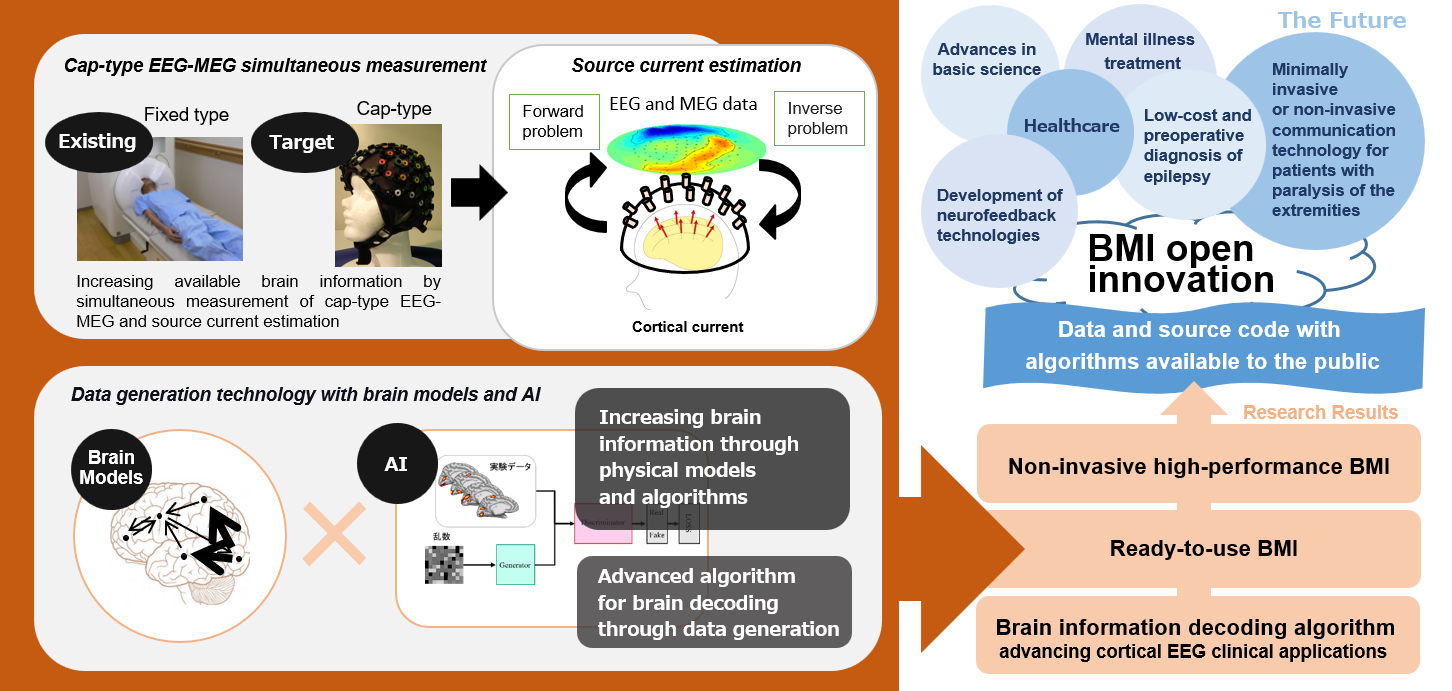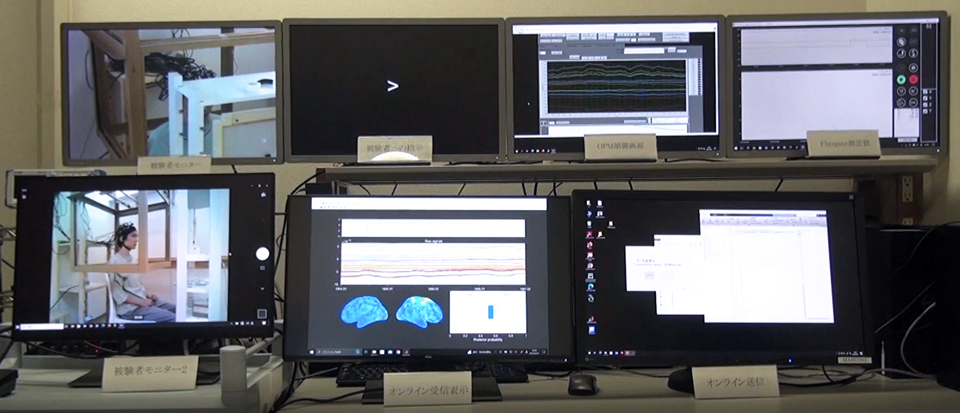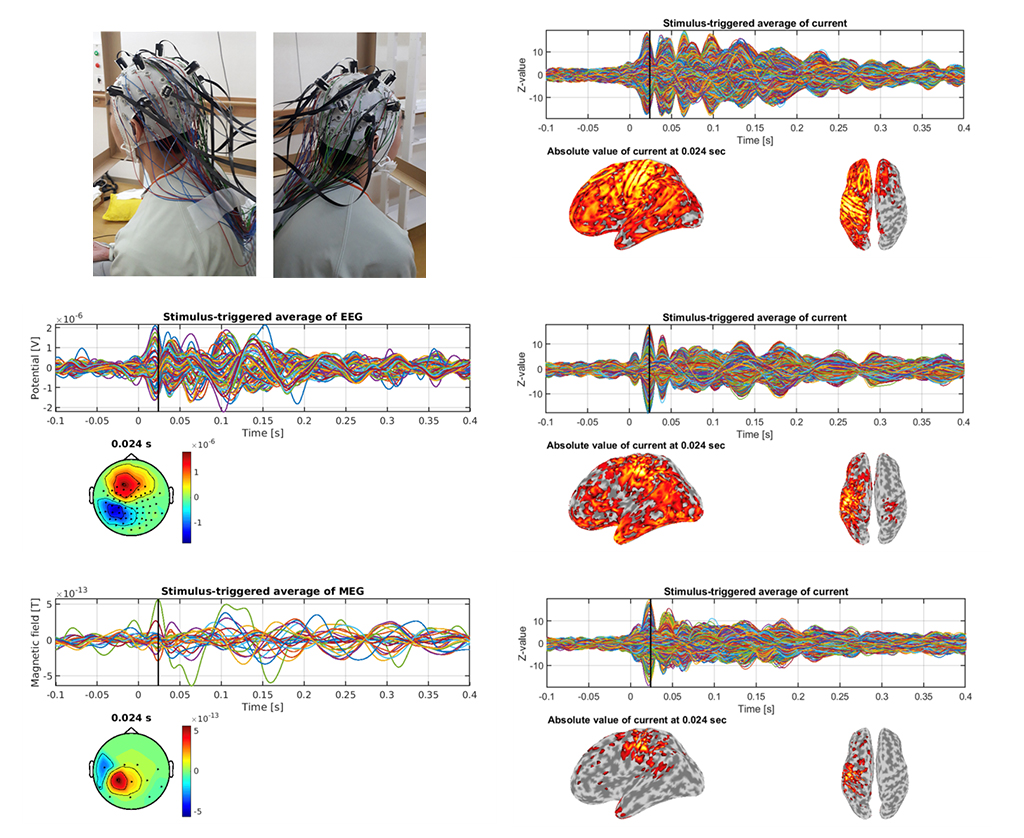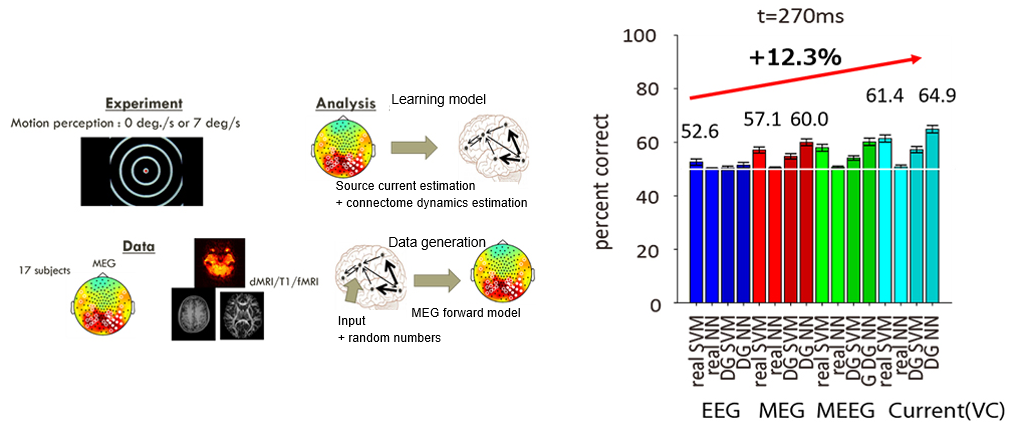Analysis of multimodal brain measurements and applying analysis to BMI open innovation
Objectives
In this study, we aim to achieve a ready-to-use, noninvasive, and high-performance BMI that can serve as basic technology for clinical application of electrocorticography (ECoG). For this purpose, we establish new noninvasive brain measurement techniques, develop brain signal analysis algorithms that connect ECoG and scalp electroencephalography (EEG), and advance algorithms for decoding brain information.
Specifically, we are developing these items:
- Simultaneous measurement system using both wearable EEG and magnetoencephalography (MEG)
- Methods for estimating cortical currents
- Data generation technology using brain models and artificial intelligence (AI)
Using simultaneous measurements of EEG and MEG along with cortical current estimation, we increase the amount of brain information available at both the measurement and analysis stages.
Then, we improve brain information decoding algorithms by data generation technology that uses a brain model and AI. By combining these technologies, we aim to achieve “ready-to-use noninvasive high-performance BMI.”
Furthermore, by making source codes and data available to the public, we intend to become a pioneer in BMI open innovation.
Achievements
Development of simultaneous measurement system of wearable EEG and MEG
We have developed an MEG measurement system using Optically Pumped Magnetometers (OPMs) (QuSpin, Inc.). We can measure OPM-MEGs with 15 sensors and 30 channels (two channels per sensor). Furthermore, we can perform simultaneous measurements of EEG and OPM-MEG and achieve real-time streamed processing of the measured data.
You can view our laboratory by taking the “Virtual Lab Tour” below.
Welcome Collaborators and Users.

Development list
- Environmental magnetic field canceling coil
- Caps to hold OPM sensors
- Sensor-position measurement system
- Simultaneous measurement system of EEG and OPM-MEG
- Real-time OPM-MEG streaming system
Developed products
Experimental scene using our real-time system (Task: Motion Imagination)
Development of cortical current estimation method
We developed VBMEG ver 3.0, a MATLAB toolbox, to estimate cortical currents from multi-channel OPM-MEG and EEG data. VBMEG ver 3.0 is now open to the public, so everyone can use it.
We published two papers related to the VBMEG toolbox; Introduction of the VBMEG toolbox (Takeda et al., 2019) and Development of a new method to estimate cortical currents using meta-analysis results of fMRIs as prior information on current variances (Suzuki et al., 2021).
Sample results of cortical current estimations
from OPM-MEG and EEG data (Task: Median Nerve Stimulation)
Data-generation technique using brain model and AI
We developed a method to generate measurement data using a brain network dynamics model that is constrained by anatomical connectivity.
By combining the data generation technique and a three-layer neural network, we improved the decoding accuracy of brain information by more than 10 % compared to current methods.
Comparison of brain information decoding accuracy
Software and data release for BMI open innovation
For open science, we released software and experimental data on the web.
- Datasets :OPM-MEG, SQUID-MEG, and EEG (OSE) dataset
- Software :VBMEG
As a part of our open source dissemination activities, we hosted a study group on MEG/EEG source imaging, built a video platform to spread information, and enhanced the content of our website.
Our collaborative research with external institutions has been published in high-impact journals (Yanagisawa et al., 2020, 2022), and thus our open science initiatives are beginning to bear fruit.
This research was supported by a contract with the National Institute of Information and Communications Technology titled “Analysis of multi-modal brain measurement data and development of its application for BMI open innovation” (209, FY 2018–2022).
References
Brookes, M. J., Leggett, J., Rea, M., Hill, R. M., Holmes, N., Boto, E., & Bowtell, R. (2022). Magnetoencephalography with optically pumped magnetometers (OPM-MEG): the next generation of functional neuroimaging. Trends in Neurosciences.
Takeda, Y., Hiroe, N., & Yamashita, O. (2021). Whole-brain propagating patterns in human resting-state brain activities. NeuroImage, Vol.245, p.118711
Suzuki, K., & Yamashita, O. (2021). MEG current source reconstruction using a meta-analysis fMRI prior. NeuroImage, 118034.
Takeda Y., Itahashi T., Sato M., Yamashita O. (2019), Estimating repetitive spatiotemporal patterns from many subjects’ resting-state fMRIs, NeuroImage, Vol 2-3, p. 116182,
Takeda Y., Suzuki K., Kawato M., Yamashita O. (2019), MEG Source Imaging and Group Analysis Using VBMEG, Frontiers in Neuroscience, 13, 241
Yanagisawa, T., Fukuma, R., Seymour, B., Tanaka, M., Yamashita, O., Hosomi, K., … & Saitoh, Y. (2022). Neurofeedback training without explicit phantom hand movements and hand-like visual feedback to modulate pain: A randomized crossover feasibility trial. The Journal of Pain, 23(12), 2080-2091.
Yanagisawa, T., Fukuma, R., Seymour, B., Tanaka, M., Hosomi, K., Yamashita, O., … & Saitoh, Y. (2020). BCI training to move a virtual hand reduces phantom limb pain: A randomized crossover trial. Neurology, 95(4), e417-e426




